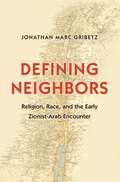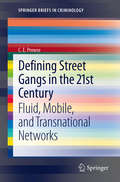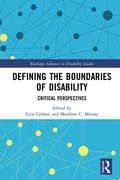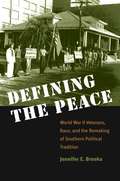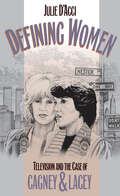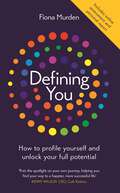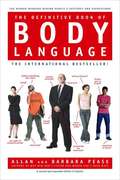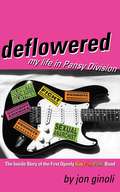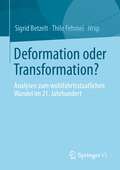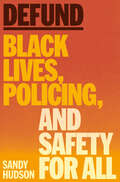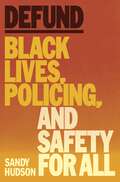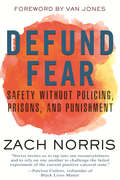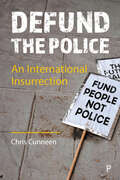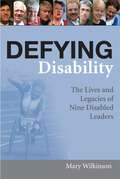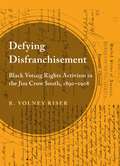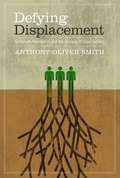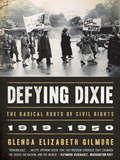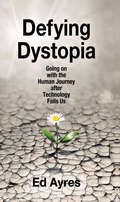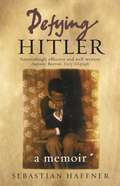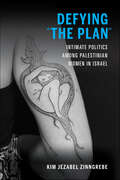- Table View
- List View
Defining Neighbors: Religion, Race, and the Early Zionist-Arab Encounter (Jews, Christians, and Muslims from the Ancient to the Modern World #58)
by Jonathan Marc GribetzHow religion and race—not nationalism—shaped early encounters between Zionists and Arabs in PalestineAs the Israeli-Palestinian conflict persists, aspiring peacemakers continue to search for the precise territorial dividing line that will satisfy both Israeli and Palestinian nationalist demands. The prevailing view assumes that this struggle is nothing more than a dispute over real estate. Defining Neighbors boldly challenges this view, shedding new light on how Zionists and Arabs understood each other in the earliest years of Zionist settlement in Palestine and suggesting that the current singular focus on boundaries misses key elements of the conflict.Drawing on archival documents as well as newspapers and other print media from the final decades of Ottoman rule, Jonathan Gribetz argues that Zionists and Arabs in pre–World War I Palestine and the broader Middle East did not think of one another or interpret each other's actions primarily in terms of territory or nationalism. Rather, they tended to view their neighbors in religious terms—as Jews, Christians, or Muslims—or as members of "scientifically" defined races—Jewish, Arab, Semitic, or otherwise. Gribetz shows how these communities perceived one another, not as strangers vying for possession of a land that each regarded as exclusively their own, but rather as deeply familiar, if at times mythologized or distorted, others. Overturning conventional wisdom about the origins of the Israeli-Palestinian conflict, Gribetz demonstrates how the seemingly intractable nationalist contest in Israel and Palestine was, at its start, conceived of in very different terms.Courageous and deeply compelling, Defining Neighbors is a landmark book that fundamentally recasts our understanding of the modern Jewish-Arab encounter and of the Middle East conflict today.
Defining Street Gangs in the 21st Century
by C. E. ProwseIn contrast to the pattern of long-standing occidental street gangs modelled in the North American paradigm, new-age gangs have appeared as loosely organized, with a high degree of interchangeability of their membership. Associated with this structural fluidity is an equally significant geographic mobility, which paradoxically does not appear to diminish the intensity of personal bonds formed within and between 'new-age' gangs. The dimensions of fluidity of gang membership and geographic mobility across police jurisdictions is increasingly seen as the organizational pattern of emerging gangs, in large part shaped by worldwide patterns of human migration and globalization. While the structure of new-age gangs appears as loose-knit, what must be emphasized is that this characteristic is reflective of a criminal network of economic commodity-based 'turf' as opposed to a close-knit geographically anchored 'turf' that has characterized the prevailing North American (occidental) gang model. This volume illuminates the structure and organization of increasingly emergent, fluid and mobile, new-age gangs within the context of transnational networks. The implications for law enforcement agencies is two-fold: i) the fluidity of new-age gang players challenges investigative techniques that remain predicated on suspect recognition through modus operandi repetition by those involved, and; ii) the movement of new-age gang players across police jurisdictions challenges the sharing of police information. This innovative work will be of interest to researchers in Criminology and Criminal Justice, as well as related disciplines including Sociology and Anthropology studying gangs and group-organization. It has strong implications for practitioners and professionals working in law enforcement, public policy, or with at-risk youth/young adults.
Defining the Age: Daniel Bell, His Time and Ours
by Paul Starr Julian E. ZelizerThe sociologist Daniel Bell was an uncommonly acute observer of the structural forces transforming the United States and other advanced societies in the twentieth century. The titles of Bell’s major books—The End of Ideology (1960), The Coming of Post-Industrial Society (1973), and The Cultural Contradictions of Capitalism (1976)—became hotly debated frameworks for understanding the era when they were published. In Defining the Age, Paul Starr and Julian E. Zelizer bring together a group of distinguished contributors to consider how well Bell’s ideas captured their historical moment and continue to provide profound insights into today’s world. Wide-ranging essays demonstrate how Bell’s writing has informed thinking about subjects such as the history of socialism, the roots of the radical right, the emerging postindustrial society, and the role of the university. The book also examines Bell’s intellectual trajectory and distinctive political stance. Calling himself “a socialist in economics, a liberal in politics, and a conservative in culture,” he resisted being pigeon-holed, especially as a neoconservative.Defining the Age features essays from historians Jenny Andersson, David A. Bell, Michael Kazin, and Margaret O’Mara; sociologist Steven Brint; media scholar Fred Turner; and political theorists Jan-Werner Müller and Stefan Eich. While differing in their judgments, they agree on one premise: Bell’s ideas deserve the kind of nuanced and serious attention that they finally receive in this book.
Defining the Boundaries of Disability: Critical Perspectives (Routledge Advances in Disability Studies)
by Licia CarlsonThis ground-breaking volume considers what it means to make claims of disability membership in view of the robust Disability Rights movement, the rich areas of academic inquiry into disability, increased philosophical attention to the nature and significance of disability, a vibrant disability culture and disability arts movement, and advances in biomedical science and technology. By focusing on the statement, "We are all disabled", the book explores the following questions: What are the philosophical, political, and practical implications of making this claim? What conceptions of disability underlie it? When, if ever, is this claim justified, and when or why might it be problematic or harmful? What are the implications of claiming "we are all disabled" amidst this global COVID-19 pandemic? These critical reflections on the boundaries of disability include perspectives from the humanities, social sciences, law, and the arts. In exploring the boundaries of disability, and the ways in which these lines are drawn theoretically, legally, medically, socially, and culturally, the authors in this volume challenge particular conceptions of disability, expand the meaning and significance of the term, and consider the implications of claiming disability as an identity. It will be of interest to a broad audience, including disability scholars, advocates and activists, philosophers and historians of disability, moral theorists, clinicians, legal scholars, and artists.
Defining the Modern Museum
by Lianne MctavishDefining the Modern Museum is a fascinating exploration of the museum as a cultural institution. Emphasizing museums' relationship to schools, libraries, and government agencies, this interdisciplinary study challenges long-standing assumptions about museums - revealing their messy, uncertain origins, and belying the standard narrative of their educational purpose having been corrupted by corporate goals.Using theoretical models and extensive archival research, Lianne McTavish examines the case of Canada's oldest continuing public museum, the New Brunswick Museum in Saint John. Focusing on the period between 1842 and the 1950s, McTavish addresses topics such as the transnational exchange of objects between museums, efforts by women to claim space within the organization, the creation of Carnegie libraries, and the rising status of curators.Shedding light on many topics of current interest, especially the commodification and globalization of museums, this study makes a lively contribution to museum studies and cultural studies.
Defining the Peace
by Jennifer E. BrooksIn the aftermath of World War II, Georgia's veterans--black, white, liberal, reactionary, pro-union, and anti-union--all found that service in the war enhanced their sense of male, political, and racial identity, but often in contradictory ways. In Defining the Peace, Jennifer E. Brooks shows how veterans competed in a protracted and sometimes violent struggle to determine the complex character of Georgia's postwar future. Brooks finds that veterans shaped the key events of the era, including the gubernatorial campaigns of both Eugene Talmadge and Herman Talmadge, the defeat of entrenched political machines in Augusta and Savannah, the terrorism perpetrated against black citizens, the CIO's drive to organize the textile South, and the controversies that dominated the 1947 Georgia General Assembly. Progressive black and white veterans forged new grassroots networks to mobilize voters against racial and economic conservatives who opposed their vision of a democratic South. Most white veterans, however, opted to support candidates who favored a conservative program of modernization that aimed to alter the state's economic landscape while sustaining its anti-union and racial traditions. As Brooks demonstrates, World War II veterans played a pivotal role in shaping the war's political impact on the South, generating a politics of race, anti-unionism, and modernization that stood as the war's most lasting political legacy.
Defining Women
by Julie D'AcciDefining Women explores the social and cultural construction of gender and the meanings of woman, women, and femininity as they were negotiated in the pioneering television series Cagney and Lacey, starring two women as New York City police detectives. Julie D'Acci illuminates the tensions between the television industry, the series production team, the mainstream and feminist press, various interest groups, and television viewers over competing notions of what women could or could not be--not only on television but in society at large. Cagney and Lacey, which aired from 1981 to 1988, was widely recognized as an innovative treatment of working women and developed a large and loyal following. While researching this book, D'Acci had unprecedented access to the set, to production meetings, and to the complete production files, including correspondence from network executives, publicity firms, and thousands of viewers. She traces the often heated debates surrounding the development of women characters and the representation of feminism on prime-time television, shows how the series was reconfigured as a 'woman's program,' and investigates questions of female spectatorship and feminist readings. Although she focuses on Cagney and Lacey, D'Acci discusses many other examples from the history of American television.
Defining You: Second edition
by Fiona MurdenDefining You helps you to understand who you are and what your place is in this hectic and demanding world. It opens a window into the process of psychological profiling and presents a clear path to improving your effectiveness and fulfilling your potential with immediate actions and tangible tips.This new edition will include:New chapter on emotional resilience – taking it&’s place among the chapters on Defining You, Describing You, Developing You, Confidently You and Optimizing You, Fiona introduces a whole new section on being Resiliently You, based on the course she runs frequently and has most latterly been running for the NHS.Everyone has emotional resilience to some degree, but the global pandemic has really tested all of us in how we use it. Coping with challenges and setbacks is a key factor in both how we manage our daily lives and how leaders make the decisions that govern our lives. Fiona has over twenty years&’ experience in both the science and practice of coaching emotional resilience.More in-depth exploration of mental health and how it affects focus and high performance.A fully revised chapter on sleep and stress relief.Introduction of the 3 S&’s concept – Sleep, Self Awareness and Social Support.
The Definitive Book of Body Language: How to read others' attitudes by their gestures
by Allan Pease Barbara PeaseThis international bestseller explains everything you need to know about body language, how to read it, and how to put your best self forwards.What people say is often very different to what they think or feel.Now, with THE DEFINITIVE BOOK OF BODY LANGUAGE, you can learn to read others people's thoughts by their gestures. It sounds implausible, but body language is easy to pick up and fun to use. Find out:How to tell if someone is lyingHow to make yourself likeableHow to get co-operation from other peopleHow to interview and negotiate successfullyHow to choose a partnerLearn the secrets of body language with Allan and Barbara Pease, bestselling authors of WHY MEN DON'T LISTEN AND WOMEN CAN'T READ MAPS.
The Definitive Book of Body Language
by Barbara Pease Allan PeaseAvailable for the first time in the United States, this international bestseller reveals the secrets of nonverbal communication to give you confidence and control in any face-to-face encounter - from making a great first impression and acing a job interview to finding the right partner. It is a scientific fact that people's gestures give away their true intentions. Yet most of us don't know how to read body language and don't realize how our own physical movements speak to others. Now the world's foremost experts on the subject share their techniques for reading body language signals to achieve success in every area of life. Drawing upon more than thirty years in the field, as well as cutting-edge research from evolutionary biology, psychology, and medical technologies that demonstrate what happens in the brain, the authors examine each component of body language and give you the basic vocabulary to read attitudes and emotions through behavior. Discover: How palms and handshakes are used to gain control; The most common gestures of liars; How the legs reveal what the mind wants to do; The most common male and female courtship gestures and signals; The secret signals of cigarettes, glasses, and makeup; The magic of smiles, including smiling advice for women; How to use nonverbal cues and signals to communicate more effectively and get the reactions you want. Filled with fascinating insights, humorous observations, and simple strategies that you can apply to any situation, this intriguing book will enrich your communication with and understanding of others as well as yourself.
Deflowered: My Life in Pansy Division
by Jon Ginoli"We're the buttfuckers of rock-and-roll, We want to sock it to your hole!" With these words written in a notebook, Jon Ginoli sets off on a journey of self-discovery and musical passion to become the founding member of Pansy Division, the first out and proud queercore punk rock band to hit the semi-big time. Set against the changing decades of music, we follow the band from their inception in San Francisco, to their search for a music label and a permanent drummer to their current status as indie rock icons. We see the highs-touring with Green Day-and the lows-homophobic fans-of striving for acceptance and success in the world of rock. Replete with the requisite tales of sex, drugs, groupies, band fights and label battles, this rollicking memoir is also an impassioned account of staying true to the artistic vision of queer rock'n'roll.
Deflowered: My Life in Pansy Division
by Jon Ginoli"We're the buttfuckers of rock-and-roll, We want to sock it to your hole!" With these words written in a notebook, Jon Ginoli sets off on a journey of self-discovery and musical passion to become the founding member of Pansy Division, the first out and proud queercore punk rock band to hit the semi-big time. Set against the changing decades of music, we follow the band from their inception in San Francisco, to their search for a music label and a permanent drummer to their current status as indie rock icons. We see the highs--touring with Green Day--and the lows--homophobic fans--of striving for acceptance and success in the world of rock. Replete with the requisite tales of sex, drugs, groupies, band fights and label battles, this rollicking memoir is also an impassioned account of staying true to the artistic vision of queer rock'n'roll.
Deformation oder Transformation?: Analysen zum wohlfahrtsstaatlichen Wandel im 21. Jahrhundert
by Sigrid Betzelt Thilo FehmelDer Sammelband verfolgt die Idee, beobachtbare De- und Transformationen der Wohlfahrtsproduktion sichtbar zu machen und daraufhin zu prüfen, wie grundlegend und wie nachhaltig sie jeweils sind. Analytisch werden dabei verschiedene Aspekte des Wandels resp. Ebenen unterschieden, auf denen sich De- und Transformationen der Wohlfahrtsproduktion manifestieren (können): der Wandel sozialpolitischer Ziele, Normen und Leitbilder, der Wandel von Akteurs- und Steuerungskonstellationen bei der Wohlfahrtsproduktion, Transformationen auf Ebene der Subjekte im transformierten Wohlfahrtsstaat und schließlich alternative Modelle der Wohlfahrtsproduktion und der sozialen Sicherung.
Defund: Black Lives, Policing, and Safety for All
by null Sandy HudsonA fiercely-argued, deeply-informed examination of why defunding the police is the only way to support a model of security and protection that increases public safety overall&“Hudson moves us past the failed rhetoric of police reform and provides a powerful analysis that reveals the harsh truth that policing produces neither safety nor justice and must be replaced by a world that meets people&’s basic needs.&” —Alex S. Vitale, author of The End of PolicingOver the last few years, in response to videos demonstrating the brutal and often deadly tactics of law enforcement officers, calls to "defund the police" have increasingly rung out across the world. But this is not a trendy new movement: Black activists have been sounding the alarm on the dangers of policing for decades. Time and again history has watched as officers respond to minor calls with escalation, wrongful arrests, and even murder. Yet policymakers continue to fund and endorse reform programs that have proven ineffective at curbing these actions. Why? Because most of what we know about policing is wrong.In Defund, longtime activist Sandy Hudson examines the origins of commonly held ideas about police and safety to show how police-related social policies are based more on a sensationalized idea of safety than on outcomes and data. She demonstrates the destructive effects of policing on scores of people, arguing that investment in community resources and infrastructure rather than law enforcement is the key to making us safer. Clear-eyed and hopeful yet incisive and pragmatic, Defund paves a clear path forward and demonstrates that a future without police is not only entirely possible, but necessary.
Defund: Black Lives, Policing, and Safety for All
by Sandy HudsonA fiercely argued, deeply informed examination of why defunding the police is the only way to support a model of security and protection that increases public safety overallTime and again we see police respond to minor calls with escalation, wrongful arrests, even murder. Reform programs are often poorly implemented and their impacts short-lived. Calls to “defund” the police have rung out across the nation, yet the actual meaning of the phrase remains unclear. In Defund, longtime activist and the founder of Black Lives Matter Canada, Sandy Hudson, elucidates what defunding the police actually means and why it matters, by exploring today’s criminal landscape and the patterns and structures that result in safer, well-resourced communities. Hudson explores the origins of commonly held ideas about police and safety to show how police-related social policies are based more on a sensationalized idea of safety than on outcomes and data. She demonstrates the destructive effects of policing on scores of people, arguing that investment in community resources and infrastructure rather than law enforcement is the key to making us safer. Clear-eyed and hopeful yet incisive and pragmatic, Defund paves a clear path forward and demonstrates that a future without police is not only entirely possible, but necessary.
Defund Fear: Safety Without Policing, Prisons, and Punishment
by Zach NorrisA groundbreaking new vision for public safety that overturns more than 200 years of fear-based discrimination, othering, and punishmentAs the effects of aggressive policing and mass incarceration harm historically marginalized communities and tear families apart, how do we define safety? In a time when the most powerful institutions in the United States are embracing the repressive and racist systems that keep many communities struggling and in fear, we need to reimagine what safety means. Community leader and lawyer Zach Norris lays out a radical way to shift the conversation about public safety away from fear and punishment and toward growth and support systems for our families and communities. In order to truly be safe, we are going to have to dismantle our mentality of Us vs. Them. By bridging the divides and building relationships with one another, we can dedicate ourselves to strategic, smart investments—meaning resources directed toward our stability and well-being, like healthcare and housing, education and living-wage jobs. This is where real safety begins.Originally published in hardcover as We Keep Us Safe: Building Secure, Just, and Inclusive Communities, Defund Fear is a blueprint of how to hold people accountable while still holding them in community. The result reinstates full humanity and agency for everyone who has been dehumanized and traumatized, so they can participate fully in life, in society, and in the fabric of our democracy.
Defund the Police: An International Insurrection
by Chris CunneenThe police are viewed as guardians of public safety and enforcers of the law. How accurate is this? Given endemic police violence which is often aimed at racialised and minoritised groups and the failure of many attempts at reform, attention has turned to community-generated models of support. These include defunding the police and instead funding alternatives to criminalisation and incarceration. This book is the first comprehensive overview of police divestment, using international examples and case studies to reimagine community safety beyond policing and imprisonment. Showcasing a range of practical examples, this topical book will be relevant for academics, policy makers, activists and all those interested in the Black Lives Matter movement, protest movements and the renewed interest in policing and abolitionism more generally.
Defying Disability: The Lives and Legacies of Nine Disabled Leaders
by Mary WilkinsonThis book tells the stories of nine disabled leaders who, by force of personality and concrete achievement, have made us think differently about disability. Whatever direction they have come from, they share a common will to change society so that disabled people get a fair deal. There are compelling biographies of: · Sir Bert Massie: public servant · Lord (Jack) Ashley: Labour politician · Rachel Hurst: activist and campaigner · Tom Shakespeare: academic · Phil Friend: entrepreneur and business consultant · Peter White: broadcaster · Mat Fraser: actor, musician and performer · Andrew Lee: activist and campaigner · Dame Tanni Grey-Thompson: Paralympic champion Defying Disability is based on extensive interviews with the subjects and the people who know them. It marks their similarities and differences, the forces that drove them to achieve, the impact they have had on policies and practice, and how the modern history of disability in the UK has been played out in their lives. Defying Disability is not just a good read; it will inform professionals in the field, students in disability studies, disabled people, their families and carers, and everyone interested in disability politics and policies.
Defying Disfranchisement: Black Voting Rights Activism in the Jim Crow South, 1890-1908
by R. Volney RiserIn the late nineteenth and early twentieth century, Jim Crow strengthened rapidly and several southern states adopted new constitutions designed primarily to strip African American men of their right to vote. Since the Fifteenth Amendment to the United States Constitution prohibited eliminating voters based on race, the South concocted property requirements, literacy tests, poll taxes, white primaries, and white control of the voting apparatus to eliminate the region's black vote almost entirely. Desperate to save their ballots, black political leaders, attorneys, preachers, and activists fought back in the courts, sustaining that resistance until the nascent NAACP took over the legal battle. In Defying Disfranchisement, R. Volney Riser documents a number of lawsuits challenging restrictive voting requirements. Though the U.S. Supreme Court received twelve of these cases, that body coldly ignored the systematic disfranchisement of black southerners. Nevertheless, as Riser shows, the attempts themselves were stunning and demonstrate that African Americans sheltered and nurtured a hope that led to wholesale changes in the American legal and political landscape.Riser chronicles numerous significant antidisfranchisement cases, from South Carolina's Mills v. Green (1985), the first such case to reach the Supreme Court, and Williams v. Mississippi, (1898), the well-known but little-understood challenge to Mississippi's constitution, to the underappreciated landmark Giles v. Harris -- described as the "Second Dred Scott" by contemporaries -- in which the Court upheld Alabama's 1901 state constitution. In between, he examines a host of voting rights campaigns waged throughout the country and legal challenges initiated across the South by both black and white southerners. Often disputatious, frequently disorganized, and woefully underfunded, the antidisfranchisement activists of 1890--1908 lost, and badly; in some cases, their repeated and infuriating defeats not only left the status quo in place but actually made things worse. Regardless, they brought attention to the problem and identified the legal questions and procedural difficulties facing African Americans. Rather than present southern blacks as victims during the roughest era of discrimination, in Defying Disfranchisement Riser demonstrates that they fought against Jim Crow harder and earlier than traditional histories allow, and they drew on their own talents and resources to do so. With slim ranks and in the face of many defeats, this daring and bold cadre comprised a true vanguard, blazing trails that subsequent generations of civil rights activists followed and improved. By making a fight at all, Riser asserts, these organizers staged a necessary and instructive prelude to the civil rights movement.
Defying Displacement
by Anthony Oliver-SmithThe uprooting and displacement of people has long been among the hardships associated with development and modernity. Indeed, the circulation of commodities, currency, and labour in modern society necessitates both social and spatial mobility. However, the displacement and resettlement of millions of people each year by large-scale infrastructural projects raises serious questions about the democratic character of the development process. Although designed to spur economic growth, many of these projects leave local people struggling against serious impoverishment and gross violations of human rights. Working from a political-ecological perspective, Anthony Oliver-Smith offers the first book to document the fight against involuntary displacement and resettlement being waged by people and communities around the world. Increasingly over the last twenty-five years, the voices of people at the grass roots are being heard. People from many societies and cultures are taking action against development-forced displacement and resettlement (DFDR) and articulating alternatives. Taking the promise of democracy seriously, they are fighting not only for their place in the world, but also for their place at the negotiating table, where decisions affecting their well-being are made.
Defying Dixie: The Radical Roots of Civil Rights, 1919-1950
by Glenda Elizabeth Gilmore"Remarkable . . . an eye-opening book [on] the freedom struggle that changed the South, the nation, and the world." --Washington Post The civil rights movement that looms over the 1950s and 1960s was the tip of an iceberg, the legal and political remnant of a broad, raucous, deeply American movement for social justice that flourished from the 1920s through the 1940s. This rich history of that early movement introduces us to a contentious mix of home-grown radicals, labor activists, newspaper editors, black workers, and intellectuals who employed every strategy imaginable to take Dixie down. In a dramatic narrative Glenda Elizabeth Gilmore deftly shows how the movement unfolded against national and global developments, gaining focus and finally arriving at a narrow but effective legal strategy for securing desegregation and political rights.
Defying Dystopia: Going on with the Human Journey After Technology Fails Us
by Ed AyresTo most, the collapse of modern civilization is the stuff of fiction. Yet, science confirms that misuse of technology and environmental abuse places our world in grave danger of ruin. The World Scientists' Warning to Humanity places our civilization on a collision course. Defying Dystopia analyses how we have come to this, and what options remain for far-seeing people to take control of their own destiny and survive the future. Ed Ayres, who has worked with some iconic environmental scientists of the past half-century, argues that technology was originally used to augment the natural strengths of humans, but has been increasingly used in ways that weaken us—shifting from useful work to the industries of distraction, entertainment, convenience, pain-relief, and sedation. Ayres advises on how at least some of us can avoid that collision. The most critical task, for those of us who want humanity to survive and thrive, is to disengage from our tech thraldom, and shift to a conscious management of our evolution in which we use technology to enhance our skills and strengths rather than erode or supplant them. Ayres provides insightful, actionable suggestions we can use to increase our odds of survival. He asks far-seeing individuals to take on a mission that the dominant governments and institutions demonstrably cannot: the epic task of shepherding a low-profile, resilient transition to a new kind of human future.
Defying Gravity
by Prill BoyleEvery day, regular women are accomplishing extraordinary things later in life. Prill Boyle gathered the encouraging stories of twelve daring and determined women who accomplished incredible things at an age when most people are beginning to wind down.
Defying Hitler: A Memoir
by Sebastian HaffnerAn absolute classic of autobiography and history - one of the few books to explore how and why the Germans were seduced by Hitler and Nazism.'If you have never read a book about Nazi Germany before, or if you have already read a thousand, I would urge you to read DEFYING HITLER. It sings with wisdom and understanding' DAILY MAILSebastian Haffner was a non-Jewish German who emigrated to England in 1938. This memoir (written in 1939 but only published now for the first time) begins in 1914 when the family summer holiday is cut short by the outbreak of war, and ends with Hitler's assumption of power in 1933. It is a portrait of himself and his own generation in Germany, those born between 1900 and 1910, and brilliantly explains through his own experiences and those of his friends how that generation came to be seduced by Hitler and Nazism. The Germans lacked an outlet for self-expression: where the French had amour, food and wine, and the British their gardens and their pets, the Germans had nothing, leading to a tendency towards mass psychosis. The upheaval of post-WWI revolution, factionalism and inflation left the Germans addicted to excitement and action: Hitler provided this, and more.
Defying "The Plan": Intimate Politics among Palestinian Women in Israel
by Kim Jezabel ZinngrebeLiving under settler colonialism and patriarchal oppressions, Palestinian women in Israel are expected to operate even the most intimate aspects of their lives according to what some call "The Plan," which dictates everything from clothing, marriage, religion, and sex to how children are born and raised. In Defying "The Plan," Kim Jezabel Zinngrebe draws from a series of moving interviews to reveal that despite various forms of intertwined oppressions by both the Israeli state and Palestinian society, Palestinian women show defiance by the quotidian choices they make in their own intimate lives under occupation, which, Zinngrebe argues, cannot be perceived as a mere corollary but constitute a pivotal and contested terrain of the struggle between settler and colonized. Defying "The Plan" explores such issues as the segregation of sexual education in Palestine; the politics of dress, menstruation, and tattoos; and the roles of class, feminism, and race. Importantly, she highlights the intersectional experiences of women typically excluded from existing accounts, such as Black Palestinian women, women with disabilities, unmarried and divorced women, Bedouin women, and LGBTQI women. The stories gathered in Defying "The Plan" trace and unpack settler colonial power at the level of the intimate and native women's various practices of defiance.
